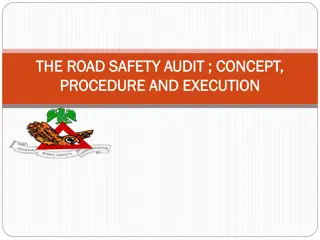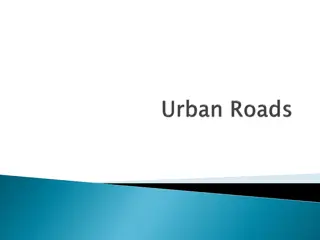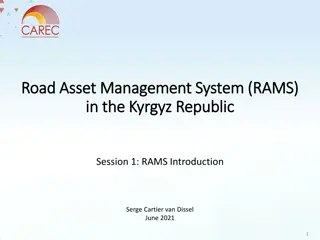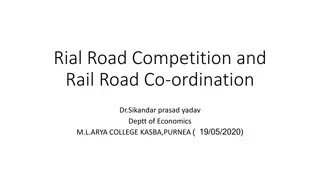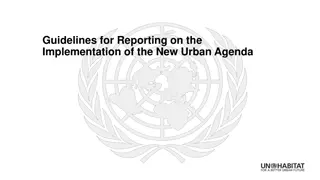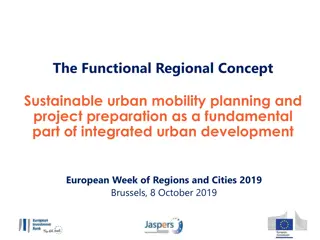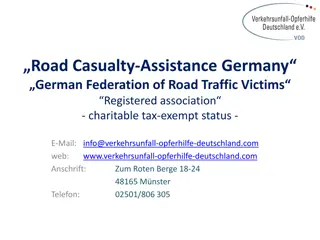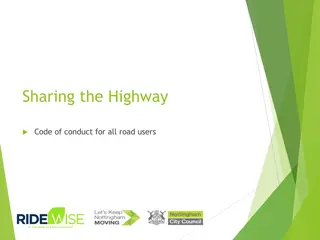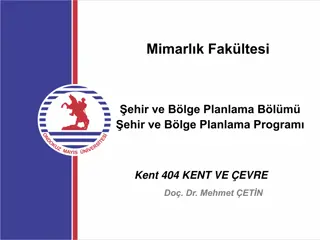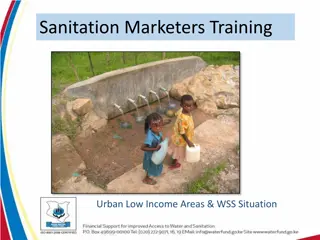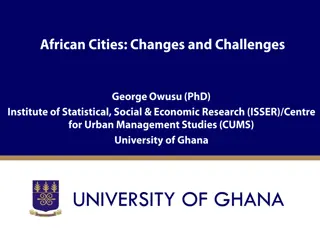Challenges and Considerations in Urban Road Location Planning
Determining the location of a new major road in urban areas is a complex and time-consuming process that involves multiple surveys and analyses. Factors such as traffic volume, road type, land use, social and environmental impacts, and town planning considerations all play a crucial role in selecting the most suitable road location. The road engineer must balance these various factors to ensure the new road enhances the overall urban infrastructure while meeting the needs of the community.
Download Presentation

Please find below an Image/Link to download the presentation.
The content on the website is provided AS IS for your information and personal use only. It may not be sold, licensed, or shared on other websites without obtaining consent from the author. Download presentation by click this link. If you encounter any issues during the download, it is possible that the publisher has removed the file from their server.
E N D
Presentation Transcript
Route Location 07 Reference: Colm A Flaherty Highways the location, design, construction & maintenance of road pavements, Chapter 1
Road location in built-up areas Determining a suitable and acceptable location for a new major road in an urban area can be most complex and challenging- and most frustrating. Because of the checks and balances that must be addressed it typically takes between 10 and 15 years to implement a major road proposal in a built-up area in the UK, i.e. from when the project is conceived to when traffic actually travels on the new road. In concept, the search for the line of a new road involves a combination reconnaissance-preliminary survey (which is dominated by transport planning activities) and a final location survey.
The reconnaissance-preliminary survey involves a transport planning investigation which is carried out in conjunction with a desk-based physical site survey. the steps involved in this survey can be summarized as follows: (1) determine the approximate traffic volume along a general corridor suggested by traffic desire lines; (2) select the road type, the number of lanes needed to carry the traffic load, and the level of service to be provided to road users; (3) establish one or more preliminary routes that meet desire-line needs, and sketch preliminary designs, including interchange and flyover locations; (4) assign traffic to one or more of the selected routes to determine design traffic volumes; (5) adjust routes and complete preliminary plans for major alternative road locations; (6) compare alternative locations using cost, environmental, road user benefit, and social analyses and select the preferred one(s) for public consultation.
The number of alternative road locations available for consideration in a builtup area are normally fairly limited. Thus, the location of a new major road or the substantial upgrading of an existing one must inevitably result in changes to portions of the established city culture which, in turn, has many direct and indirect impacts upon owners and users of the affected urban infrastructure. Whilst traffic needs and desires lines are obviously important factors affecting the location of a new major road they must always be qualified by an evaluation of the road's effect upon, and relationship with, land use and related town planning considerations. Town planning is concerned with the present and future needs of the business, industrial, residential, and recreational elements of a town so that a pleasant and functional whole is assured now and into the future. Thus, the road engineer is actively participating in town planning when locating and designing a new road and should be willing to take into account social and environmental needs, where necessary, during the location process. Whilst land and social costs are normally critical factors affecting road location in a built-up area, topography and underlying geotechnical conditions are still important controls. For example, a high water table or rock close to the surface normally precludes a depressed road, even though it may be desirable for other reasons. Similarly, poor subsoil conditions may prevent the construction of a long length of elevated roadway.
The final location survey in an urban area is similar to that for a rural area, except that it is usually more difficult to carry out. For example, very rarely in an urban area can a continuous centreline be pegged directly because of the many obstructions that are encountered. Until the ground is cleared for roadworks to begin, it is always necessary to set out the centreline by means of complicated off-setting and referencing. Taking profile and cross-section levels prior to gaining control of the land upon which the road is to be built is always a complicated task; the survey team is not only faced with difficult sighting problems but its members may also be subjected to the concerns of property owners who are not terribly enthusiastic about granting them access to their properties.
Bridges The reconnaissance survey is carried out to get information on the locations of all possible bridge sites, to examine the comparative suitability of each site (including obtaining preliminary estimates of construction costs), and, finally, to establish the need for the stream crossing within a limited zone. Data gathered during the deskbased component of this study : (1) requirements of statutory bodies controlling waterways, e.g. port, water and planning authorities, and fisheries; (2) topographical and marine survey data to supplement Ordnance Survey maps and Admiralty charts and publications; (3) available detailed information about rivers, the size and nature of catchment areas, tidal limits, flood levels, and their relationships to Ordnance Datum; (4) observations on tidal levels and fluctuations, velocities and directions of currents, variations in depth, and wave data; (5) information on scour and siltation, and on the movement of foreshore material by drift; (6) location and effects of existing river or marine structures, wrecks, or other obstructions above or below the waterline. (7) observations on the conditions of existing structures, e.g. attack by marine growth and borers, corrosion of metalwork, disintegration of concrete, and attrition by floating debris or bed movements.
The preliminary location survey is carried out to determine the alignment within the limited zone selected by the reconnaissance survey, and to obtain the physical data needed for the acquisition of land and the design of the bridge. Ideally, this should result in the shortest crossing being selected, i.e. at right angles to the stream, as this normally results in the cheapest construction cost. skew bridges are more costly than right-angled ones and longer bridges are normally more expensive than shorter ones, the end effect is generally a better and more economically operated road. The preliminary location survey usually includes a preliminary triangulation to establish the starting coordinates for traverses at the bridge-heads and along the approaches, topographic surveys along these traverses, and the design of a more elaborate triangulation system that can be used later to lay out the detailed construction. In addition, a hydrographic survey is normally carried out to determine the hydraulic or flow characteristics of the water at the proposed crossing, as well as longitudinal and cross-section details of the channel bottom. Other hydrographic data collected will, of course, vary with the type of crossing and the location and exposure of the proposed structure, but it always includes engineering and geological surveys of the subsurface foundation conditions.
The final location survey normally has two components, the pre- construction survey and the construction survey. Pre-construction survey operations normally involve the establishment of the horizontal control stations and benchmarks that constitute the fundamental framework that defines lines and grades; much of this work may be carried out during the preliminary survey but, generally, some subsequent refinement and strengthening is needed to improve its accuracy. The construction survey operations provide the intermediate and final positioning, both horizontally and vertically, of the various components of the bridge structure. The importance of attaining high accuracy in this survey cannot be over-emphasized, if wasteful delays and needless expenditures are to be avoided.




